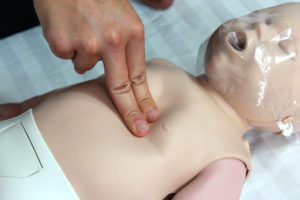CPR Steps for Infants
-
- Place 2 or 3 fingers of one hand on the sternum in the middle of the nipple line (Figure 46).
- Press straight down. Compressions should be 1.5 inches (4 cm) into the infant’s chest (or about 1/3 the diameter of the chest) and at a rate of 100 to 120 compressions per minute.
- Be sure that between each compression you completely stop pressing on the chest and allow the chest wall to return to its natural position. Leaning or resting on the chest between compressions can keep the heart from refilling in between each compression and make CPR less effective.

Figure 46
- After 30 compressions, or 15 compressions for 2 rescuers, stop compressions and open the airway by tilting the head and lifting the chin.
- Put your hand on the infant’s forehead and tilt the head back. Lift the infant’s jaw by placing your index and middle fingers on the lower jaw; lift up. Aim for a neutral neck position and do not overextend the neck.
- Do not perform the head-tilt/chin-lift maneuver if you suspect the infant may have a neck injury.
In that case, the jaw-thrust is used. Lift the infant’s jaw by placing your index and middle fingers
on the lower jaw; lift straight up. If their lips are closed, open the lower lip using your thumb.
- Give a breath while watching the chest rise. Repeat while giving a second breath. Breaths should be delivered over one second.
- Resume chest compressions. Switch quickly between compressions and rescue breaths to minimize interruptions in chest compressions.
